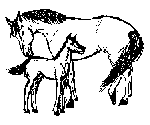Scheduling Deworming Treatments
SCHEDULING TREATMENT OF OUR HORSES FOR INTERNAL PARASITES.
The proper scheduling of deworming treatments for our horses is just about as important as the products used. To determine the optimal treatment schedule we must take into account such factors as: the number of horses on the farm, their ages, how many years there have been horses on this farm, are cows allowed to run with or rotate through the pastures the horses graze, and do the pastures provide grass or is hay fed to supplement the forages.
One constant suggestion is that the deworming products be rotated with each deworming. Two unrelated products can be used. If you are unsure of their relations, just read the ingredients list or the small print under the brand name which is usually in bold lettering.
The more horses on a parcel of land and the longer time horses have been on that land, the more often the horses there now need to be dewormed. Worm eggs are passed in the stool and, until hatched, will live for many months or years. Therefore we can understand the cumulative affect of having many horses on the same ground for many years. Once this has been established, we should assume the horses are consuming worms with every bite of grass and will continue to do so as long as this ground is used. Only on ground never occupied by horses, or pastures grazed with cattle at the same time or in rotation, can we be comfortable the horses are not continually taking in new worms. The cattle worms are not a problem in horses, and the cattle will ingest the horse worms but their development stops there and they do not reproduce.
Horses, unless maintained on a continues deworming product from weaning, will benefit from a deworming whenever it is given. We must determine what is practical for the individual farm, assuming the horse is maintaining its body condition.
Strongid C dewormer added to the daily feed will provide the best control of worms. If there is just one horse on ten acres or more of pasture, two dewormings per year should be enough:
As the number of horses increase and/or the acreage decreases, the number of dewormings should increase. Quarterly deworming would be indicated for groups of two or more, unless they are on very large pasture areas. For those farms with several head--almost regardless of the acreage available--deworming every other month may be enough.
It is difficult to give a specific schedule because of the number of factors involved. There is, however, a simple way to evaluate the success of your deworming program. All you have to do is collect a small amount of fresh stool and store it in the refrigerator until it can be dropped off at the clinic. The tablespoon size sample can be stored in a plastic bag and should be labeled with the horse’s name. To do a herd evaluation, samples from two horses (or 10% of the herd, whichever is greater) should be submitted. We will do a fecal exam to check for worm eggs. From this exam we can determine the presence of parasites and, by the number of eggs, get a rough idea of how successful the current deworming program is.
Of course, there are also external parasites that plague the horses, but many of these are eliminated with the medicine and procedures for treatment of bots. The ticks, which are hanging on for dear life right now, will persist deep in the hair coat well into the winter. Most of the time we see the effect of the lice and mites later in the winter and in early spring. More on these later...
CLICK BELOW TO DISPLAY A PRINTER-FRIENDLY COPY OF THIS ARTICLE
Select "Open this file from its current location," if you just want to print it out,
it will open in a simple word processing application, select the print button.
(unless you want to save this article in your computer's memory)

 SCHEDULING_TREATMENT.rtf
SCHEDULING_TREATMENT.rtf